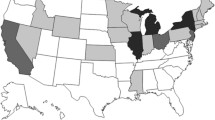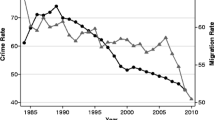Abstract
Using a new source of data, we estimate the probability of apprehension among Mexican migrants attempting to cross into the United States without documents. Over the period 1965-1989 we found an average apprehension probability of .35, confirming earlier estimates. We then applied annual probabilities to estimate the gross volume of undocumented Mexican migration and adjusted these figures to derive estimates of the net undocumented inflow.
Similar content being viewed by others
References
Bean, F.D. 1994. Testimony before Hearings by the Commission on Immigration Reform, EI Paso, March 18-19.
Bean, F.D., T.J. Espenshade, M.J. White, and R.F. Dymowksi. 1990. “Post-IRCA Changes in the Volume and Composition of Undocumented Migration to the United States: An Assessment Based on Apprehensions Data.” Pp. 111–58 in Undocumented Migration to the United States: IRCA and the Experience of the I 980s, edited by F.D. Bean, B. Edmonston, and J.S. Passel. Washington, DC: Urban Institute.
Calavita, K. 1992. Inside the State: The Bracero Program, Immigration, and the I.N.S. New York: Routledge.
Camp, R.A. 1993. Politics in Mexico. New York: Oxford University Press.
Computing Resource Center. 1992. Stata Reference Manual, Vol. 3. Santa Monica: Computing Resource Center.
Crane, K., B.J. Asch, J.Z. Heilbrunn, and D.C. Cullinane. 1990. The Effect of Employer Sanctions on the Flow of Undocumented Immigrants to the United States. Santa Monica: RAND.
Donato, K.M., J. Durand, and D.S. Massey. 1992. “Stemming the Tide? Assessing the Deterrent Effects of the Immigration Reform and Control Act.” Demography 29:139–58.
Durand, J., and D.S. Massey. 1992. “Mexican Migration to the United States: A Critical Review.” Latin American Research Review 27:3–42.
Espenshade, T.J. 1990. “Undocumented Migration to the United States: Evidence from a Repeated Trials Model.” pp. 159–81 in Undocumented Migration to the United States: IRCA and the Experience of the 1980s, edited by F.D. Bean, B. Edmonston, and J.S. Passel. Washington, DC: Urban Institute.
1994. “Does the Threat of Apprehension Deter Undocumented U.S. Immigration?” Population and Development Review 20:871–92.
Espenshade, T.J., and D. Acevedo. 1995. “Migrant Cohort Size, Enforcement Effort, and the Apprehension of Undocumented Aliens.” Population Research and Policy Review, forthcoming.
Goodman, L. 1961. “Snowball Sampling.” Annals of Mathematical Statistics 32:117–51.
Gregory, P. 1986. The Myth of Market Failure: Employment and the Labor Market in Mexico. Baltimore: Johns Hopkins University Press.
Jones, R.C. 1988. “Micro Source Regions of Mexican Undocumented Migration.“ National Geographic Research 4: 11–22.
Kenkel, J.L. 1989. Introductory Statistics for Management and Economics. Boston: PWS-Kent.
Kossoudji, S.A. 1992. “Playing Cat and Mouse at the U.S.-Mexican Border.” Demography 29:159–80.
Massey, D.S. 1987. “The Ethnosurvey in Theory and Practice.” International Migration Review 21: 1498–1522.
Massey, D.S., L.P. Goldring, and J. Durand. “Continuities in Transnational Migration: An Analysis of 19 Mexican Communities.” American Journal of Sociology 99: 1492-1533.
Massey, D.S., and E. Parrado. 1994. “Migradollars: The Remittances and Savings of Mexican Migrants to the United States.” Population Research and Policy Review 13:3–30.
Reimers, D.M. 1985. Still the Golden Door: The Third World Comes to America. New York: Columbia University Press.
Sanchez, R. 1994. “Arizona Border Swamped as Illegals Seek Easy Entry.” Phoenix Gazette, March 18, p. 1.
Sheahan, J. 1991. Conflict and Change in Mexican Economic Strategy: Implications for Mexico and Latin America. La Jolla: Center for U.S. -Mexican Studies, University of California, San Diego.
Singer, A., K.M. Donato, and J. Durand. 1994. “The Social Process of Border Crossing: Undocumented Mexican Migrants to the United States.” Presented at the annual meetings of the Population Association of America, Miami.
Sudman, S. 1983. “Applied Sampling.” Pp. 145–94 in Handbook of Survey Research, edited by P.H. Rossi, J.D. Wright, and A.B. Anderson. Orlando: Academic Press.
U.S. Immigration and Naturalization Service. 1992. Immigration Reform and Control Act: Report on the Legalized Alien Population. Washington, DC: U.S. Government Printing Office.
Author information
Authors and Affiliations
Additional information
We are grateful to Robert Warren, Karen Woodrow-Lafield, Katharine Donato, and Thomas Espenshade for their helpful comments and suggestions on an earlier draft of this article.
Rights and permissions
About this article
Cite this article
Massey, D.S., Singer, A. New Estimates of Undocumented Mexican Migration and the Probability of Apprehension*. Demography 32, 203–213 (1995). https://doi.org/10.2307/2061740
Issue Date:
DOI: https://doi.org/10.2307/2061740




